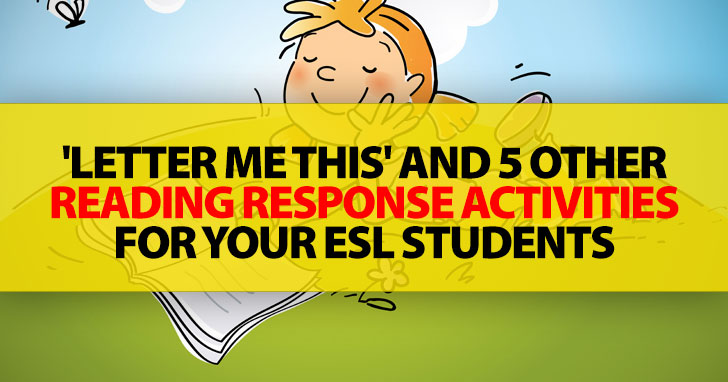'Letter Me This' And 5 Other Reading Response Activities For Your ESL Students


We love following our favorite characters through adventure after misadventure. We can imagine ourselves in a different setting, perhaps a different world when stories take us to imaginary places or locations across the globe. Since readers get so much entertainment value from reading fictional pieces, they may be our automatic choice in the ESL classroom. For those of us, though, who have realized the great benefits nonfiction has to offer, we may think twice before choosing fiction over nonfiction. If you are thinking about using nonfiction in your ESL classroom or you already do, here are some benefits your students and you are getting.

No matter what age your English students are, nonfiction offers topics that tie into their personal interests. Younger children are naturally drawn to information about animals, cars and other topics while older students are fascinated with technology and music. Whether younger or older, your students can find nonfiction material to satisfy their curiosity and interest in their favorite topics. When your students are interested in reading about a given topic, they are more self motivated to read and fulfill that curiosity, and you can watch as their literacy levels rise as they do! Using nonfiction texts in your classroom ties into these personal interests and may even spark new passions in some of your students.
Many ESL students unintentionally limit their vocabulary bank to words used in conversational settings. By using nonfiction in your ESL classroom, your students will expand their vocabularies in areas that do not necessarily come up in everyday conversation. Nonfiction will challenge your students, but it will also give them a broader vocabulary base, especially texts from the fields of science and social studies.
Many nonfiction books include photographs to illustrate the authors’ points. Photographs can be a great aid to your students as they strive to understand English text. Photos offer more detail and a clearer depiction of the world around us than do illustrations. When they are able to refer to photographs, your students will increase their comprehension level and make connections to the real world they see around them.
One of the best curriculum strategies for ESL students follows a cyclical pattern. By introducing specific sets of vocabulary several different times during the year, your students will internalize that material better and retain it longer. Nonfiction lends itself perfectly to a cyclical curriculum because similar content and vocabulary can be used to introduce different and increasingly complex grammatical concepts. Because your students will be familiar with the information and vocabulary your nonfiction text offers, they will be freer to absorb more complex grammatical and linguistic concepts introduced through that content as the year goes on.
Nonfiction has a lot to offer ESL students in the way of comprehension clues, too. Teaching your students how to read nonfiction elements like the index, glossary, table of contents, headings and subheadings will give them a head start once they begin reading the text itself. Teach your students to look at these items before they read the text and make predictions about what their reading will reveal. Also, point out photos, diagrams and captions and ask your students to predict what they might read. This will help prepare them to understand more before they tackle the text.
While we sometimes ask our students to write fictional pieces, most of what we assign as writing projects results in nonfiction pieces. Reading and breaking down nonfiction text will give your students a model to follow as they write their own nonfiction essays, reports and compositions. When you read a nonfiction text in class, take time to look at the organization and point out to your students how the author places his information. Then challenge your students to employ that same model when they write their own pieces.
Not only will reading nonfiction help your students know how to write, it will give them ideas of what to write about as well. When students are encouraged to pursue and research the topics that interest them, they will have more information to draw on when they write their own nonfiction pieces. Show your students how to use a writer’s notebook to record ideas for future compositions, and encourage them to add to this notebook as they read about interesting topics.
More and more, younger students are expected to go beyond the simple reporting of facts and use critical thinking to analyze what they read. Your students who read nonfiction will use higher order thinking skills as they read and analyze texts, and that will help become better learners. If your students take standardized tests, you can also be confident that those students who can think critically will perform better on standardized tests.
Students who are new to the U.S. or whose lives at home do not reflect that of the typical U.S. student may have a difficult time relating to the main characters of fictional texts traditionally used in classrooms. Reading nonfiction eliminates the cultural barrier that fiction may place between internationals and main characters. When you use nonfiction in your classroom, your students may also develop a more global perspective on their lives and the lives of their fellow students. Likewise, you will have more opportunities to promote cultural acceptance and understanding among your students when you read about people and places all over the world.
Ultimately, giving your students plenty of practice reading nonfiction prepares them for their futures. 86% (!) of what adults read is nonfiction. Whether on the job or in the classroom, your students will be better prepared for the reading requirements of adulthood when they are well versed at reading nonfiction in your classroom.
What are your favorite nonfiction texts to use in your ESL class?